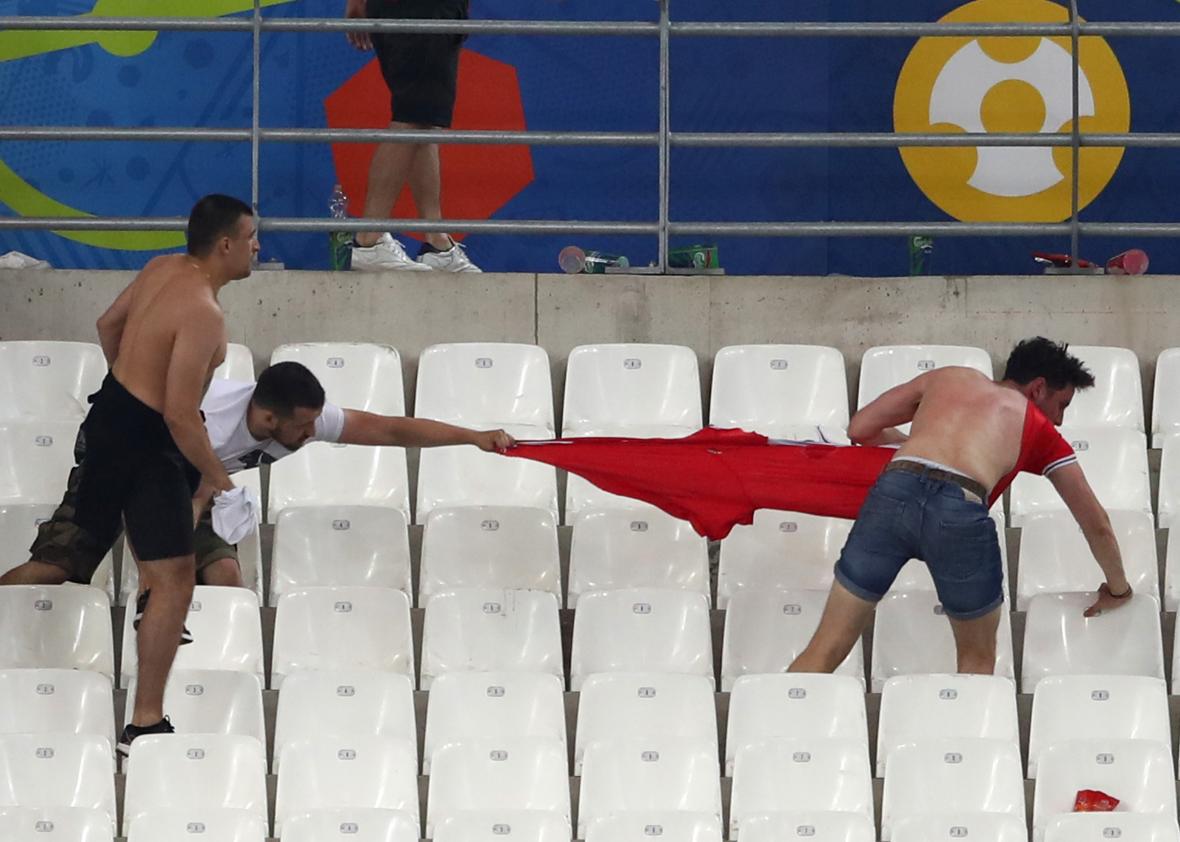For the few of us Americans who were paying attention to soccer in the 1980s, the game was often synonymous with violence. My memories of the very first live professional soccer game I attended are not of sparkling offense (this was late 1980s Arsenal) or dogged defense, but of fear. I can’t tell you who won that day, but I can tell you about the terraces crumbling around the railings of the stands, the loutish fans that groped a female friend of mine, the frightfully narrow turnstiles that would become meat grinders if there was a rush to the exits, and the helmeted mounted policemen patrolling the streets before and after the match. This was all part of the thrilling and repulsive atmosphere of English football, and it was fascinating in the Latin sense of the word: It cast an evil spell.
This evil was the subject of the first book I ever read about soccer, Bill Buford’s Among the Thugs, which I picked up in the early 1990s just as English football was cleaning up its act in the wake of the tragedies at Hillsborough and Heysel. Changes in stadium design, rules about drinking at games, better security measures, and efforts to recruit fans into the fight against hooliganism mean that, with a few grisly exceptions, attending a football match in Europe doesn’t usually mean taking your life into your hands. With the creation of the Premier League in 1992, the game began its rehabilitation in the land of its birth, becoming the multibillion-dollar, family-friendly, largely-inaccessible-in-person-to-the-working-class stadium spectacle that we have today. While nostalgia for the days when schoolboys could attend games for less than a pound still runs high in some quarters, very few pine for the days when a Saturday afternoon spent in the stands could very well mean a Saturday night spent in the hospital.
These days Americans who consider themselves soccer fans are likely to support a Premier League club and may have no memories of the bad old days. The beatings and, to a lesser extent, the racism seem to belong to another time, or perhaps another place. But racist chants continue to be heard frequently in Spain, fans in Italy are knifed, and overall soccer violence in continental Europe seems to be on the rise. This year’s Euros have so far been as notable for fan violence as for the quality of play. After brawls between Russian and English fans both inside and outside the stadium in Marseille last week, UEFA considered banning both sides from the tournament straightaway and on Tuesday handed down a suspended disqualification to Russia, which means any more in-stadium violence will result in the Russians being kicked out of the tournament. (Though Wednesday’s game against Slovakia was quieter in that regard, one fan did manage to smuggle a flare into the stadium.)

Lars Baron/Getty Images
France had been preparing for violence at this year’s tournament, but not the sort of hooliganism that until recently seemed to be on the wane. After last November’s terrorist attacks in Paris, French authorities were on guard for something much worse than drunken punch-ups and vandalism. If we are fortunate, nothing that horrible will mar the Euros, but so far it’s the crowds themselves that are more violent than any in recent memory. To make matters worse, this violence was being met with an initial shrug—followed by encouragement, with a dash of homophobia thrown in—by the very Russian officials who will be hosting the next World Cup. They have since begun to walk back this laissez-faire attitude, but how hooligans will respond to their government’s pleas and what all this means for when the world gathers in Russia in 2018 is anyone’s guess.
In the midst of all this, we are forced to consider that large gatherings of people can easily become targets for larger attack. One of the targets of the Paris terrorists was a France-Germany match at the Stade de France, the stadium where this year’s Euros kicked off. Those terrorists may have chosen soccer because it is a symbol of capitalism, even if a number of French players are Muslims. Soccer used to have important class dimensions and in some places different clubs are associated with different political positions, or with different religions. But most of the violence in stadiums is generally perpetrated by one group that has a manufactured hatred of another based on an allegiance to a club or country, rather than to football itself.
For close to 20 years, Europeans were largely successful in making soccer safe, but that seems to be changing. Perhaps the new economic uncertainty—a kind similar to that which plagued Britain in the Thatcher years and which may have contributed to the anger that fueled that era’s hooliganism—is behind the comeback in endogenous football violence. Of course, any danger from hooligans is eclipsed by the exogenous violence of terrorists. In the case of both hooliganism and terrorism, though, our public gathering places get wrested from us. The changes in England after Hillsborough and Heysel show that it is possible to make football stadiums safer. The terrorist attack at the Stade de France showed that it will never be possible to make them completely safe.
Read more Slate coverage of Euro 2016 and Copa America.
